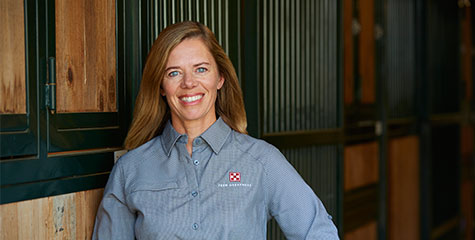Feeding Overweight Horses
Addressing weight gain in horses is multi-factorial. Controlling pasture and/or forage intake, feeding a ration balancer or low-calorie feed, and encouraging exercise are all required. Weight can be monitored via body condition scoring and utilization of a weight tape. For horses that are obese (body condition score 7+ and/or show signs and symptoms of insulin resistance or endocrinopathic laminitis) refer to Feeding Metabolic Horses for more specific recommendations for that condition.
Diagnosing Overweight Horses
Horses’ body condition should be continually monitored via body condition scoring and use of a research-based weight tape. Once horses reach a body condition score of 6 (moderately fleshy) they should be regularly evaluated to not gain additional condition. When horses reach a body condition score of 7-9 (fleshy to extremely fat) a weight loss program should be implemented.Feed Management for the Overweight Horse
To start, overweight horses should not be fed large amounts of grain or concentrate feeds. Focus on feeding a ration balancer or low-calorie, low-fat, low-sugar/starch feed in small amounts. A ration balancing feed such as as Enrich Plus® or Enrich Plus® Senior (both at 1500 Kcal/lb, 0.1 lbs per 100 lbs BW minimum feeding rate per day) or Omega Match Ration Balancing Feed (1250 Kcal/lb, 0.2 lbs per 100 lbs BW minimum feeding rate per day), or low-calorie feeds such as WellSolve® W/C (900 Kcal/lb), WellSolve® L/S (1200 Kcal/lb), Miniature Horse and Pony (1275 Kcal/lb) or Strategy® Healthy Edge® (1300 Kcal/lb) can all be used to balance forage-based rations.Navigating Access to Pasture
Overweight horses should have limited to no access to lush pasture. Restricting pasture time or utilizing a grazing muzzle can help decrease pasture intake. Time limits may not be enough to control pasture intake for some horses, as they can binge eat grass in short periods of turnout. In this case, muzzles and time limits should be utilized together. Dry lots are also an excellent option for these horses.Handling Hay for Overweight Horses
Overweight horses should be offered moderate quality grass hay at 1.5% of current body weight, split into several meals per day. Using small hole hay nets will help to extend meal times. If 1.5% body weight in grass hay is not enough to facilitate weight loss, some horses need to be lowered to 1.2% body weight in grass hay. Rich hays should be avoided such as alfalfa or grass hays with relative feed values greater than 125.Exercise
Exercise should be encouraged via whatever means possible, including hand-walking, riding, driving, lunging, etc. Every bit of exercise helps but adding exercise won’t induce weight loss if the other parts of the weight loss program are not also implemented.In summary, the steps for weight loss in horses are:
- Control, limit and/or prohibit access to pasture via time limits, grazing muzzles or using a dry lot.
- Feed moderate quality grass hay at 1.2-1.5% of body weight, split into several meals and fed through a small-hole hay net.
- Eliminate high calorie feeds and high feeding rates. Feed a ration balancer or low-calorie feed in small amounts.
- Encourage exercise and movement through riding, lunging, driving, walks or other means.
1 Equine Applied and Clinical Nutrition: Health, Welfare and Performance. Edited by R.J. Geor, P.A. Harris, M. Coenen. Textbook, Elsevier. 2013.
2 National Research Council. Nutrient Requirements of Horses: Sixth Revised Edition. Washington, DC: The National Academies Press, 2007.

